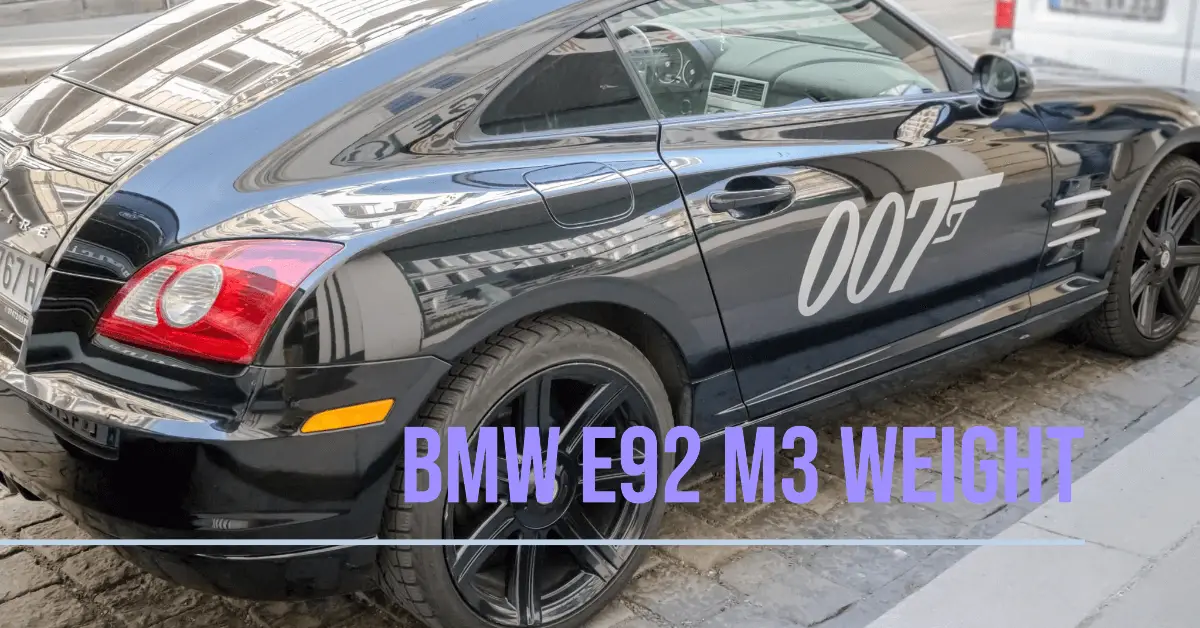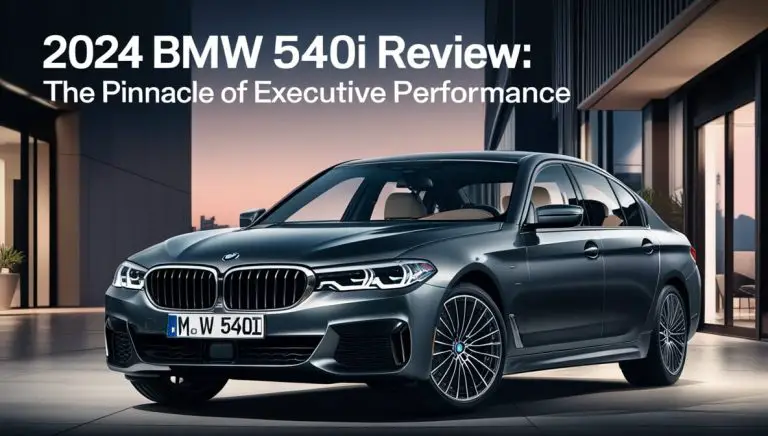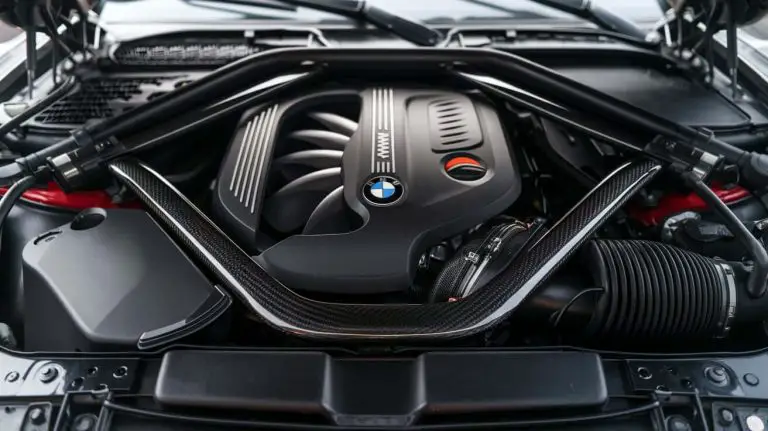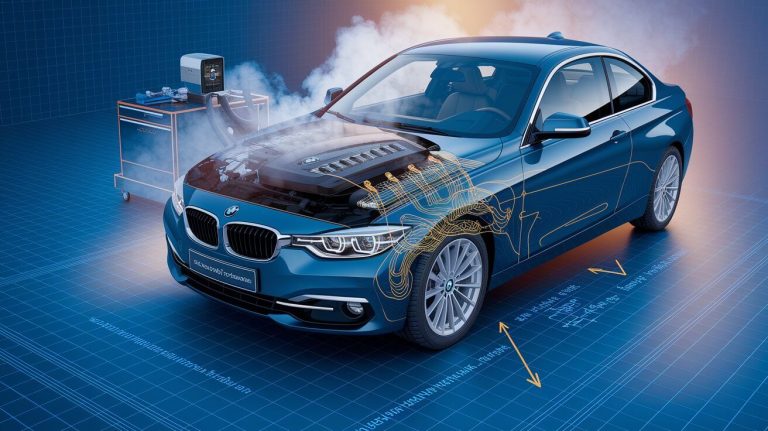The E92 M3 Weight: A Crucial Factor in the Legendary M3’s Performance
The BMW E92 M3, produced from 2008-2013, is considered one of the greatest M3 models of all time. Its high-revving 414 horsepower V8 engine, razor sharp handling, and head-turning good looks make it a modern icon.
But there’s one key specification that played a critical role in shaping the E92 M3’s character – its weight.
This in-depth guide will explore all the details around the E92 M3 weight, how it impacted performance, and provide fascinating facts about the importance of weight savings in this legendary BMW:
E92 M3 Curb Weight Overview
First, let’s look at the basic E92 M3 weight specs:
- Curb weight ranged from 3,704 lbs to 3,850 lbs depending on transmission and options
- Aluminum was used for the hood, roof, and suspension parts
- The roof was also available in carbon fiber, saving 10 lbs
- Near perfect 50/50 front/rear weight distribution
While not supercar light, BMW engineers worked hard to optimize the weight while maintaining everyday drivability. Strategic use of lightweight materials helped keep heft in check.
Now let’s look closer at the key factors that make up the full E92 M3 weight profile.
Engine and Drivetrain Contributions
The E92 M3 featured a high revving 4.0L V8 (internally called the S65B40). This naturally aspirated engine weighed in at 415 lbs fully dressed with all accessories.
The 6-speed manual transmission added another 88 lbs. Opting for the 7-speed dual clutch automatic (called M-DCT) brought the transmission weight up to 143 lbs.
The lightweight driveshaft weighed just 30 lbs. Other drivetrain components like the rear axle and limited slip differential added roughly 115 lbs.
All in, the complete engine and drivetrain contributed around 650 lbs to the total E92 M3 weight.
Chassis, Body and Interior Weight Impact
Several key components made up the rest of the E92 M3 weight:
- The aluminum intensive chassis weighed around 450 lbs.
- Body panels and exterior parts were approximately 875 lbs.
- Interior components like seats, carpet and dashboard came in around 375 lbs.
- Fluids, electrics, and other small items were roughly 125 lbs.
Together with the engine and drivetrain, these major sections summed up the full curb weight of 3,704 lbs.
BMW engineers meticulously analyzed every component to minimize excess weight where possible. Even small details like lighter weight wiring looms helped optimize overall heft.
Weight Reduction Highlights
Digging into the details reveals where BMW shaved weight on the E92 compared to previous M3 generations:
- Aluminum roof cut 44 lbs versus the steel top on the E46
- Carbon fiber roof option on later cars saved 10 lbs over aluminum
- No spare tire or tire repair kit subtracted 25 lbs
- Lack of trunk trim and lining reduced weight by 15 lbs
- Thinner gauge steel on body panels cut around 50 lbs
These reductions added up to a significant weight decrease versus earlier M3s. Next let’s look at how engineers achieved these savings.
Key Weight Reduction Methods
BMW utilized several important techniques to optimize the E92 M3 weight:
- Material substitution – Aluminum and carbon fiber parts replaced heavier steel components
- Part integration – Some chassis and body panels incorporated multiple parts into one through improved design
- Part elimination – No spare tire, less sound insulation and trim removal decreased weight
- Part thinning – New manufacturing methods produced thinner gauge steel panels
- Supply chain partnership – Working closely with parts suppliers to develop weight optimized components
While not as extensive as an all-out carbon fiber build, BMW’s strategic weight reductions maximized performance while retaining a refined road car.
Weight Distribution – The 50/50 Key
While the total weight number is important, how that weight is distributed in the car is equally crucial. Here the E92 M3 shined with its near perfect 50/50 front/rear weight balance.
This even distribution contributed to the M3’s fantastic handling and poise. It also required meticulous engineering to achieve the ideal balance:
- Lightweight front strut tower brace
- Smaller front brakes than rear
- Lightweight aluminum front control arms
- Positioning of the battery in the trunk area
Attaining 50/50 weight distribution resulted in confident, neutral handling right at the limit. It allowed the M3’s capabilities to shine on both road and racetrack.
Weight Impact on Performance
So why was reducing weight such a priority? What were the performance benefits?
Shedding pounds provided several key advantages:
- Better acceleration – Less mass to accelerate improved 0-60 times. BMW claimed 4.1 seconds but many tested in the high 3 second range.
- Increased cornering grip – Less weight allowed higher g-forces and cornering speeds before losing traction.
- More nimble handling – A lighter chassis reduces rotational inertia, facilitating rapid changes of direction.
- Enhanced braking performance – Shorter stopping distances thanks to having less momentum to decelerate.
- Improved fuel efficiency – Though not a priority for the M3, weight savings still provided a small boost in mpg.
In the relentless pursuit of driving perfection, reducing mass played a major role. Lightweighting amplified the capabilities of the M3’s already potent powertrain and chassis.
Weight Comparison to Rivals
So how did the M3 measure up against its rivals on the scales? Here’s how the BMW compared:
| Car | Curb Weight |
|---|---|
| BMW E92 M3 | 3,704 lbs |
| Mercedes C63 AMG | 3,825 lbs |
| Audi RS4 | 3,932 lbs |
| Lexus IS-F | 3,780 lbs |
The M3 benefitted from being lighter than competitors, especially the chunkier Audi RS4. This weight advantage contributed to the E92 M3 regularly beating rivals in comparison tests.
Weight Reduction Effectiveness
Modifying an E92 M3 provides real world examples of how weight savings translate to performance gains:
- 100 lbs reduction => 0.2s better 0-60 mph time
- 50 lbs reduction => 3 foot shorter braking distance
- 75 lbs reduction => Approximately +0.04g skidpad grip
- 30 lbs reduction => Up to 1 second faster lap time
Based on owner data, shedding just 50-75 lbs makes a measurable difference in acceleration, braking, and handling. Over 100 lbs reduction starts to yield even more significant improvements.
This quantifies just how effective even modest weight reductions can be. Lightening an already well-optimized car like the M3 still provides worthwhile performance benefits.
Reliability Impact of Weight
Does the E92 M3’s weight impact reliability? In general, added mass does increase wear on components like:
- Brake pads and rotors – Heavier cars experience greater thermal load under braking
- Suspension bushings – Higher unsprung weight strains components like control arm bushings
- Clutch and drivetrain – More rotational mass adds stress when accelerating
However, the E92 M3 powertrain and chassis were engineered for durability, so weight had a minimal effect on longevity. Nonetheless, shedding pounds does extend the life of wear items to some degree.
E92 M3 Weight vs. Modern Sports Cars
While lightweight for its time, how does the E92 M3 compare to modern sports cars?
Today’s most capable coupes have raised the bar for low mass:
| Car | Curb Weight |
|---|---|
| 2020 BMW M2 CS | 3,450 lbs |
| 2022 Porsche 718 Cayman GTS | 3,254 lbs |
| 2022 Toyota GR Supra 3.0 | 3,372 lbs |
The E92 is no longer an outlier, but its weight still remains competitive with newer rivals. The BMW’s larger size and luxury focus help justify its higher mass.
Considering the E92’s era, its weight reduction efforts were truly impressive. Even judged against today’s standards, it still delivers an appealing blend of low(ish) weight and daily drivability.
Common E92 M3 Weight Questions
Here are answers to some common questions related to the E92 M3’s weight:
How much does stripping the interior reduce weight?
Removing rear seats, carpet, sound insulation, and trunk trim saves approximately 80-100 lbs depending on components deleted. Lightweight racing seats gain back 30 lbs. Net weight reduction around 50-70 lbs.
Which upgrades provide the best weight savings per dollar?
Wheels, exhaust, springs, carbon aero, and seats provide the most bang-for-buck. Skip ultra light batteries and titanium bolts that cost a fortune.
How much weight does the carbon roof save over aluminum?
Carbon fiber roof panels weigh around 10 lbs less than the aluminum top according to BMW. Plus it lowers center of gravity.
Is the manual or DCT transmission lighter?
The 6-speed manual weighs 55 lbs less than the 7-speed DCT. Less mass and driver engagement make it the enthusiasts choice.
Does lightweighting increase resale value?
Lightly modified E92 M3s typically demand higher resale prices. But stripping out too much luxury or convenience items reduces daily livability which narrows buyer appeal. There’s an art to maximizing value via weight savings.
Conclusion
This in-depth guide demonstrates the lengths BMW went to optimize every gram on the E92 M3. Meticulous lightweight engineering was a key ingredient enabling the E92 to become a modern icon.
While horsepower and advanced electronics grabbed headlines, diligent weight reduction efforts deserve significant credit. Combined with an ideal 50/50 weight balance, lighter weight amplified the E92 M3’s capabilities to sensations levels.
Understanding the details around weight provides greater insight into what made the E92 M3 so special. Each of the hundreds of pounds shed enabled it to ascend to the top of the M3 pantheon.







